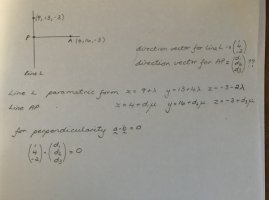Intersection of straight lines (vectors)
- Thread starter Foggy
- Start date
pka
Elite Member
- Joined
- Jan 29, 2005
- Messages
- 11,988
Why not post what you have done? We will check the work.I'm getting myself muddled on this one. I know that the vector dot product will be zero for perpendicular vectors. I've worked out the point on line L and its direction vector but I'm going round in circles. Any help appreciated!
View attachment 28531
In terms of λ what is AP ?
Last edited:
When I couldn't work out how to use a.b=0, I then went on to try equating the x,y and z from each line. However I dont know what to do in this method when there are the extra variables d1,d2,d3 from the unknown direction vector.
equating x: 9+lambda = 4 + d1 mu
equating y: 13 + 4 lambda = 16 + d2 mu
equating z: -3 - 2 lambda = -3 + d3 mu
equating x: 9+lambda = 4 + d1 mu
equating y: 13 + 4 lambda = 16 + d2 mu
equating z: -3 - 2 lambda = -3 + d3 mu


